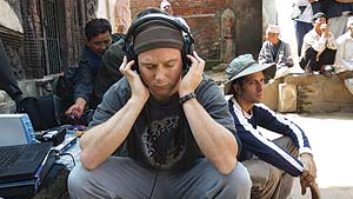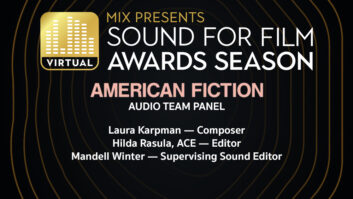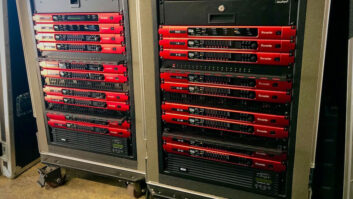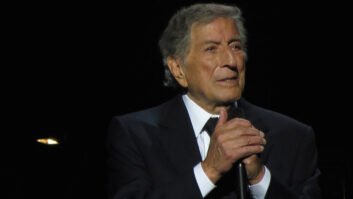It’s a great time for American Roots music. With the multi-Platinum success of the soundtrack for O Brother, Where Art Thou? and accelerating interest in Americana artists like Lucinda Williams, Steve Earle, Gillian Welch, Alison Krauss and others, it’s clear that the public is hungry for something besides factory-tooled mainstream country, lightweight boy bands and Britney-pop.
On October 29, PBS presented the first program in a 4-part television series called American Roots Music. The series covers folk, gospel, country, blues, Tejano, Cajun, Zydeco and Native American music, and features an impressive collection of historic film clips together with new live performances from a huge list of influential artists.
The series was produced by Jim Brown’s Ginger Group Productions, in collaboration with Sam Pollard and Jeff Rosen. According to three-time Emmy Award-winner Brown, whose credits include We Shall Overcome, Child of Mine, A Vision Shared: A Tribute To Woody Guthrie and The Weavers: Wasn’t That a Time!, the project grew out of his realization, during the early ’90s, that there did not exist a comprehensive collection of the filmed performances of the important movers and shakers of American Roots music. Urged on by his friend William Ivey (who later became chairman for the National Endowment for the Arts), Brown began the research necessary to locate these films.
“When Bill [Ivey] said, ‘Why don’t you put together a think tank,’ we immediately began thinking of all the institutions in America that had expertise in music,” says Brown. “Even though radio and records helped cause all of this music to flower and blossom and progress, there was another technology involved, and I was absolutely astounded at how many of these pioneers of music got filmed over the years. These tapes are all over the place, and there really are only a handful of us who have some sense of how wide this [field] is and where the stuff is. That really was the genesis.”
Brown’s collaborators soon included Emmy- and Peabody Award-winner Sam Pollard, whose credits include the docu-films I’ll Make Me a World and Four Little Girls, and Jeff Rosen, who produced Bob Dylan’s Biograph and Miles Davis: The Columbia Years box sets, plus The Bob Dylan 30th Anniversary Tribute and Sweet Home Chicago.
Rosen became a valuable source for archival music film, in part because he has worked with Bob Dylan’s organization for years. “Dylan loves to watch this stuff in the bus, and I knew that he had this big private collection,” says Brown. “Jeff [Rosen] said, ‘Whatever it is that you need, I’ll copy stuff off for you.’ During the first couple of years of researching this, I realized that Jeff knew the ground pretty well. It was a labor of love for him. He just wanted this music preserved, and they opened their collection to us.”
Besides Rosen’s and Dylan’s organization, Brown also drew on the private archives of experts throughout the country, and the series also includes material sourced from The Library of Congress, The Smithsonian Institution, The Rock & Roll Hall of Fame, The Country Music Hall of Fame and The Experience Music Project.
REMASTERING ACROSS THE DECADES
Alan Silverman, who specializes in audiophile restoration and mastering, handled the restoration, remastering and some of the mixes for the new recordings. “Something like this is challenging from the mastering standpoint, because there are so many sources and genres of music spanning many decades,” says Silverman. “There are so many levels of recording quality, ranging from field recordings to newsreel recordings to new studio recordings. Some stuff came off of old TV shows from the ’60s.
“The trick for me was to try and focus on the voice and get as much continuity as possible in the sound and level of the voices,” explains Silverman. “What I try to achieve is a warmth and a fullness, even on some of the thinner and most distorted sources.”
For equalization, Silverman used a Weiss Linear Phase Equalizer. “I think it is probably the best EQ that has ever been made,” he notes. “That allows me a lot of latitude, in terms of equalizing the selections so that they play consistently. I find that the Weiss unit is a savior, because you can do things that aren’t possible with other EQs. The penalty is almost nil, so if you want to do something extreme, you can do it without the noise suddenly becoming so phase-shifted and gnarly-sounding that it is more of a detraction than an improvement. I’m also using a really nice tool kit from a company called Algorithmix from Germany. It is a series of software tools that do de-clicking and de-noising that are very high-quality.” Silverman also made use of a Crane Song HEDD unit, which he describes as “a harmonic-manipulating device that allows you to work with the harmonic structure of tracks to fatten or clarify things without using EQ.
“You can’t really change the character of these things — nor would you want to,” notes Silverman. “But when you start to put the music into sequence, there has to be some kind of continuity for the listener to enjoy it. It needs to sound like a record that stands on its own, rather than a documentary amalgam.” Silverman made all of the A/D transfers in the 96kHz/24-bit format via a Weiss SFC2 24-bit synchronous sample rate converter and listened to playback over Dunlavy Aletha monitors.
Palm Pictures will be putting out a 2-DVD set, which will probably include some performances not seen on the TV show. Palm also will be releasing a 4-CD set featuring the music that is showcased in the special. It is programmed by genre: a country disc, a blues disc, a disc that contains gospel and folk, and a fourth disc that contains Cajun, Zydeco, Tejano and Native American.
“It is really a beautiful set,” says Rich Bauer, compilation producer/executive producer on behalf of Palm. “We are very careful that everything that we selected for the box was actually part of the show. About a third of the tracks on the program are classic recordings, another third are historic film sources, and about a third of it are contemporary new recordings that the producers had recorded while they were out researching and shooting and interviewing for the show.
“Just being able to see footage of artists like Howlin’ Wolf and Sonny Boy is incredible,” enthuses Bauer. “You’ve heard about them and heard them, but you never really got to watch them play, and seeing the performances is amazing! But then again, you only get to see and hear 30- to 45-second chunks of it. On the box set, you will get to hear the entire performance.”
SCORING WITH SKAGGS
The depth and breadth of familiar and rediscovered performances featured in the 4-part special is extraordinary. Film footage and/or recordings feature such blues giants as Bessie Smith, Robert John-son, James Cotton, Son House, Howlin’ Wolf, Muddy Waters, B.B. King and Robert Lockwood Jr. Country legends who appear in the series include Roy Acuff, Gene Autry, Bill Monroe, Ernest Tubb, the Carter Family, Bob Wills, Ralph Stanley and Hank Williams. Representing gospel and folk are the Golden Gate Quartet, Sister Rosetta Tharpe, Woody Guthrie, Leadbelly, The Weavers, the Staple Singers and Mahalia Jackson. Tejano, Cajun/Zydeco and Native American artists featured include Clifton Chenier, Narciso Martinez, Lydia Mendoza, Flaco Jimenez, Floyd Red Crow Westerman and Navajo recordings from the early 1900s.
To complement this diversity, producer Jim Brown enlisted country music and bluegrass legend Ricky Skaggs to create a multifaceted musical theme that would reflect the broad range of musical genres and personal styles onscreen. According to remastering engineer Alan Silverman, blending various genres into a common theme helps provide a thematic continuum for the series. “It sort of reflects a Jim Brown trademark of his music films,” says Silverman. “If you have seen any of his classic films, like We Shall Overcome or Child of Mine, what he’ll do is pick a song that reflects the tone of the project and record each of the guest artists doing that song, and then kind of do a continuous montage from one artist to the other. With Skaggs’ theme, Jim [Brown] had a bunch of the newly recorded artists get together in the studio and trade off — so it is kind of like an overture in a sense. It gives you a taste of some of the artists to come on the set, and it is really nicely done.”
Skaggs recorded the theme at his own studio in Hendersonville, Tenn., with an all-star band that included many of the artists featured in the TV series. In addition to Skaggs, the lineup included Earl Scruggs and Stuart Duncan, blues legend James Cotton, Cajun stalwart Mark Savoy and many others.
“This is not a group that probably would’ve gotten together normally, and yet they totally enjoyed each other’s music and there was a pretty common thread through it all,” comments series producer Brown. “Too often, we think of these music genres as being finite. In fact, until I did this project, I had always thought that blues was the forerunner to jazz. That is true to an extent, but they are really on parallel tracks. You get somebody like Lonnie Johnson, who was playing with Armstrong — he heard those solos and began playing single-note solos, which really wasn’t too prominent [a feature of guitar blues at that point]. So jazz was inspiring blues as much as blues informed jazz. I think that was absolutely the same with country music — especially with Bob Wills and Texas music.”
By organizing and preserving many of the seminal musical performances of the 20th century, the PBS series makes an important contribution to the nation’s culture. “I once worked a lot with Harry Belafonte, and he taught me that music is like the front porch of a culture,” explains Brown. “It is often where people first look and see each other. America has been looking for ways to explore its multi-ethnic culture, and to me, I think the best way to do that is through the music. I think this is as important as learning about the Constitution or learning about the Civil War. This really rich, incredible music history couldn’t have happened any place else but America, and only in the 20th century. It exploded from almost nothing. It was really an incredible set of events.”






